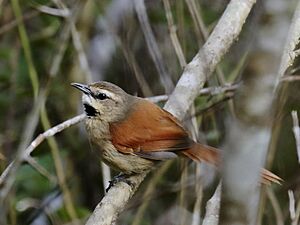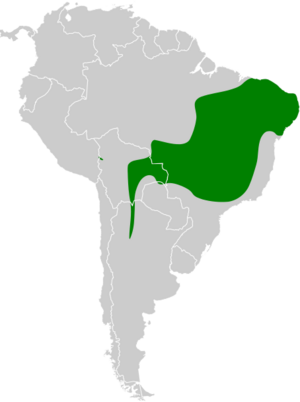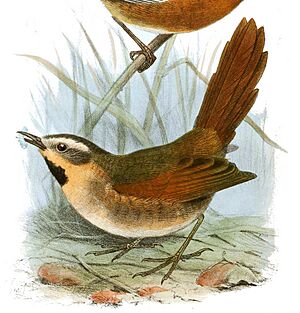Ochre-cheeked spinetail facts for kids
Quick facts for kids Ochre-cheeked spinetail |
|
|---|---|
 |
|
| Conservation status | |
| Scientific classification | |
| Genus: |
Synallaxis
|
| Species: |
scutata
|
 |
|
The ochre-cheeked spinetail is a small bird. It belongs to the ovenbird family called Furnariidae. You can find this bird in several South American countries. These include Argentina, Bolivia, Brazil, Paraguay, and Peru. Its scientific name is Synallaxis scutata.
Contents
About the Ochre-cheeked Spinetail
What's in a Name?
Scientists group living things into different families. The ochre-cheeked spinetail is part of the Synallaxis group. It is also a close relative, or "sister species," to the grey-bellied spinetail.
There are two main types, or subspecies, of the ochre-cheeked spinetail. These are S. s. scutata and S. s. whitii. Scientists like Philip Sclater first described these birds.
How to Spot an Ochre-cheeked Spinetail
Size and Appearance
This spinetail is about 13 to 14 cm (5 to 5.5 inches) long. It weighs between 12 and 19 grams (0.4 to 0.7 ounces). Both male and female birds look the same.
Feather Colors
The bird has a white stripe above its eye. It has dark areas near its eyes. Its cheeks and chin area are a warm, yellowish-brown color. A small black spot is on its forehead.
Its head and upper back are grayish-brown. The rest of its back is a dark reddish-brown. Its wings are mostly reddish-brown too. The tail is also reddish-brown. The tips of its tail feathers look spiky.
The throat is white with a black crescent shape below it. Its chest is pinkish-brown. The belly is lighter, with a white center.
Other Features
The bird's eyes are dark brown. Its upper beak is black or dark gray. The lower beak is gray or blue-gray. Its legs and feet are greenish-gray. Young birds have faint dark marks on their chest.
The S. s. whitii subspecies looks a bit different. Its upper parts are all brown, not reddish-brown. Its wings and tail are a darker reddish-brown. Its face and belly are a deeper yellowish-brown color.
Where Ochre-cheeked Spinetails Live
Their Home Range
The S. s. scutata subspecies lives in eastern and central Brazil. The S. s. whitii subspecies is found in southern Brazil. It also lives in southeastern Bolivia and northwestern Argentina. You might even find them in parts of Paraguay and Peru.
Preferred Habitat
These birds like to live in the undergrowth of forests. They prefer semi-deciduous and deciduous forests. These are forests where trees lose some or all of their leaves. In Brazil, they live in areas called caatinga and cerrado. They can be found from sea level up to about 1,700 meters (5,600 feet) high.
Ochre-cheeked Spinetail Behavior
Daily Life
The ochre-cheeked spinetail stays in the same area all year. It does not migrate.
What They Eat
These birds mainly eat arthropods. Arthropods are creatures like insects and spiders. They usually hunt for food in pairs. Sometimes, they join other bird species to find food together. They mostly pick up their food from the ground.
Reproduction and Nests
Ochre-cheeked spinetails likely breed during the local wet season. This is usually in the spring and summer in the southern parts of the world. Eggs have been found in Brazil in April. Young birds have been seen in Argentina in November.
Their nest is made of twigs, roots, and dead leaves. It can be twice as long as it is wide. A tunnel leads to the egg chamber inside. The nest is built on the ground. It often looks like a pile of natural debris. They usually lay two to three eggs. We don't know how long the eggs take to hatch. We also don't know much about how the parents care for the young.
Their Song
The ochre-cheeked spinetail has a unique song. It sounds like a very high, thin "fweeet puh-wit." The first part goes up in pitch. The second note is lower than the first and third. They repeat this song constantly, about once every second.
Conservation Status
Is the Spinetail Safe?
The IUCN (International Union for Conservation of Nature) has assessed this bird. They consider the ochre-cheeked spinetail to be of "Least Concern." This means it is not currently in danger of extinction.
It lives across a very large area. Its exact population size is unknown. However, scientists believe the number of these birds might be slowly decreasing. No major threats have been found for this species. It is considered uncommon in some places but fairly common in others. It also lives in a few protected natural areas.



